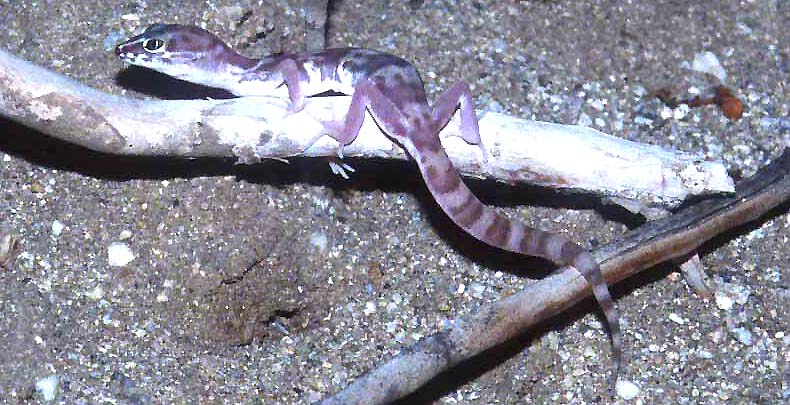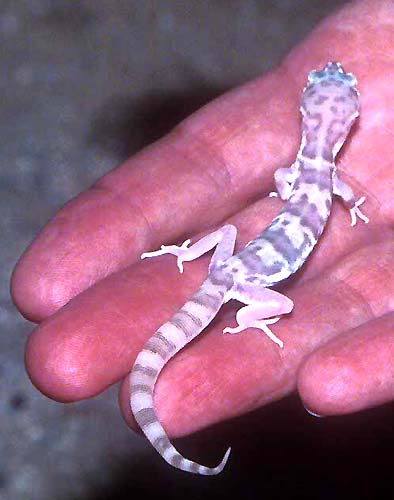 |
 California
has three native geckos (a couple of introduced species exist locally in
certain cities). The most widespread, and the only one I've seen, is the
Western
Banded Gecko Coleonyx variegatus (both photos on this page).
These are small (only ~3 inches in total length), cute, nocturnal creatures.
Although appearing very delicate, they can live in extremely dry parts
of the desert "due to nocturnal and subterranean habits" (Stebbins 2003).
Stebbins (2003) also says "To find these lizards, drive slowly along blacktop
roads and watch for small, pale, twiglike forms." In two evenings of night
driving out of Borrego Springs, San Diego Co., in mid-summer 2003, Dan
Singer and I found 4-5 of these little guys. They are said to be the commonest
herp found on night drives there; our experience was consistent with that
claim. California
has three native geckos (a couple of introduced species exist locally in
certain cities). The most widespread, and the only one I've seen, is the
Western
Banded Gecko Coleonyx variegatus (both photos on this page).
These are small (only ~3 inches in total length), cute, nocturnal creatures.
Although appearing very delicate, they can live in extremely dry parts
of the desert "due to nocturnal and subterranean habits" (Stebbins 2003).
Stebbins (2003) also says "To find these lizards, drive slowly along blacktop
roads and watch for small, pale, twiglike forms." In two evenings of night
driving out of Borrego Springs, San Diego Co., in mid-summer 2003, Dan
Singer and I found 4-5 of these little guys. They are said to be the commonest
herp found on night drives there; our experience was consistent with that
claim.
Western Banded Gecko ranges throughout the California deserts, north to the San Joaquin Valley and to Death Valley. This population, the nominate subspecies, is known as the Desert Banded Gecko. It has a spotted head, as does the one photographed here. Another race, San Diego Banded Gecko C. v. abbotti, occurs in the Peninsular Mts. of s. California; it has an unspotted head. Banded Geckos are said to often squeak when they are caught, but all our finds were silent. Hanson & Hanson (1997) describe that geckos are threatened, "they stand on their legs and hold their tails over their backs, similar to a scorpion; they even wiggle them. Some researchers think this mimicry might be an attempt to deter predators; others believe that the tail wiggling serves to divert a predator's attention, since geckos' tails, like those of many lizards, break off readily (and grow back) should they be grabbed." Our geckos did none of these fancy maneuvers — they just ran very fast when we tried to pick them up to get off the highway! One wouldn't think something so fragile appearing and translucent could run so fast.... A much rarer species is Barefoot Gecko C. switaki, which ranges from Borrego Springs vicinity south into n. Baja California. It was discovered to science relatively recently (1974) and remains rather little known. Stebbins (2003) says "Nocturnal habits and use of deep crevices make this gecko difficult to find." The final California native gecko is Leaf-toed Gecko Phyllodactyllus xanti, also mostly from Baja California, but that exists in a narrow strip along the desert edge of the Peninsula Range north to Palm Springs, Riverside Co. It prefers canyons with massive boulders where it "is an excellent climber that seldom ventures far from rocks, hence seldom round on roadways at night" (Stebbins 2003). |